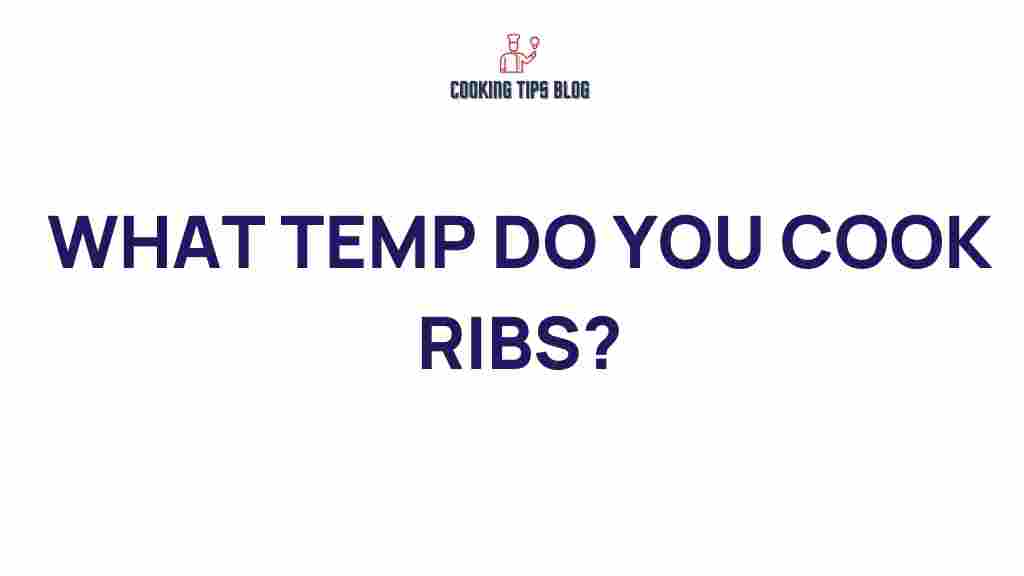The Perfect Ribs: What Temperature Should You Really Cook Them At?
Cooking ribs to perfection is both an art and a science. Whether you’re planning a backyard barbecue, a family gathering, or simply want to indulge in some delicious ribs, understanding the ideal cooking temperature is crucial. In this article, we will explore the best temperatures for cooking ribs, various methods you can use, and even some troubleshooting tips to ensure your ribs come out tender and full of flavor every time.
Understanding Ribs
Before we dive into the specifics of cooking temperatures, it’s essential to understand the different types of ribs available:
- Baby Back Ribs: These are shorter and more tender, typically cooked faster.
- Spare Ribs: Larger and meatier, they require a longer cooking time.
- St. Louis Style Ribs: A trimmed version of spare ribs, offering a good balance of meat and fat.
Each type of rib will require different cooking times and temperatures to achieve that perfect fall-off-the-bone tenderness.
Ideal Cooking Temperatures for Ribs
When it comes to cooking ribs, the key is low and slow. Here are the recommended temperatures based on the cooking method:
- Smoked Ribs: 225°F to 250°F (107°C to 121°C)
- Baked Ribs: 275°F to 300°F (135°C to 149°C)
- Grilled Ribs: 300°F to 350°F (149°C to 177°C)
Cooking ribs at these temperatures allows the fat to render slowly, resulting in tender and flavorful meat.
Step-by-Step Process for Cooking Ribs
Here’s a simple, step-by-step process for cooking ribs perfectly:
1. Choose Your Ribs
Start by selecting the type of ribs you want to cook. Consider your audience and preferences—baby back ribs are great for a tender option, while spare ribs offer more meat.
2. Prepare the Ribs
Remove the membrane from the back of the ribs, as this can prevent seasonings from penetrating and can be tough when cooked. Rinse and pat the ribs dry.
3. Season the Ribs
Use a dry rub of your choice. Common ingredients include:
- Brown sugar
- Paprika
- Garlic powder
- Onion powder
- Salt and pepper
Generously coat the ribs and let them marinate for at least an hour, or overnight for deeper flavor.
4. Preheat Your Cooking Equipment
Whether you’re using a smoker, oven, or grill, preheat it to your desired temperature based on the method outlined above.
5. Cook the Ribs
Place the ribs on the cooking surface. For smoking, use indirect heat and place a water pan in the smoker to maintain humidity. For baking, wrap the ribs in foil for the first half of cooking to retain moisture. If grilling, keep the ribs away from direct flames.
6. Monitor the Internal Temperature
Use a meat thermometer to check the internal temperature of the ribs. The ideal temperature for ribs is around 190°F to 203°F (88°C to 95°C) for optimal tenderness.
7. Rest the Ribs
Once cooked, remove the ribs and let them rest for about 10-15 minutes before cutting. This allows the juices to redistribute, ensuring juicy ribs.
Troubleshooting Tips for Cooking Ribs
If you encounter issues while cooking ribs, don’t worry! Here are some common problems and their solutions:
- Ribs Are Tough: If your ribs are tough, they likely weren’t cooked long enough. Return them to heat and cook until they reach the ideal tenderness.
- Ribs Are Dry: To prevent dryness, ensure you’re cooking at a low temperature and consider wrapping them in foil during cooking.
- Uneven Cooking: If some parts of the ribs are cooked more than others, rotate them regularly for even heat distribution.
For more tips on cooking ribs and perfecting your barbecue skills, visit this helpful resource.
Conclusion
Cooking the perfect ribs is all about understanding the right temperatures and methods. By keeping your cooking temperature low and slow, you ensure that the meat becomes tender and flavorful. Remember to choose the right type of ribs, season them well, and monitor their progress with a thermometer. With these tips and techniques, you’ll be able to serve up a plate of mouthwatering ribs that will impress your family and friends.
For more culinary insights and recipes, check out our cooking blog for inspiration and tips on mastering your grill or smoker!
This article is in the category Tools and created by Cookingtipsblog Team
